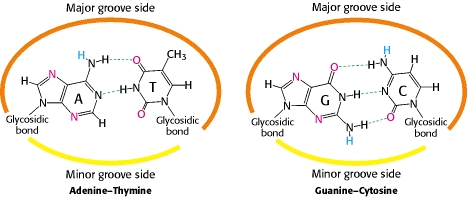
| MadSci Network: General Biology |
Hi Paul,
Thanks for submitting your question to the MadSci Network. I note that you ask two very different questions in your submission. In the subject of your question, you ask about the major and minor grooves of the DNA molecule, but in the body of your question you ask about the major and minor strands of the DNA molecule.
There are no major or minor strands of the DNA molecule (we all love them both equally), so I will answer the question about the major and minor grooves.
The major and minor grooves result from the overall geometry of the Watson-Crick base-pair. It you look at an A:T, T:A, G:C, or C:G base pair, you will notice that the glycosidic bonds are in about the same place in all base-pairs, and that they are oblique with respect to one another. You can see an example of this in the figure below, which is taken from Chapter 27.1.2 of the textbook Biochemistry by L. Stryer.

This figure depicts an A:T and a G:C base pair. If you extend the glycosidic bond in each base-pair to form an imaginary line, the lines will form an obtuse and an acute angle. The major and minor grooves form between the phosphate backbones of the DNA molecule, so that the obtuse angle forms the major groove, and the acute angle forms the minor groove.
Thats it!
Keep asking questions, and have a groove-ie day!
Try the links in the MadSci Library for more information on General Biology.